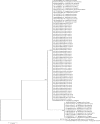Genetic Characterization of Fasciola Isolates from West Azerbaijan Province Iran Based on ITS1 and ITS2 Sequence of Ribosomal DNA
- PMID: 27095969
- PMCID: PMC4835470
Genetic Characterization of Fasciola Isolates from West Azerbaijan Province Iran Based on ITS1 and ITS2 Sequence of Ribosomal DNA
Abstract
Background: Fascioliasis, caused by Fasciola hepatica and F. gigantica, has medical and economic importance in the world. Molecular approaches comparing traditional methods using for identification and characterization of Fasciola spp. are precise and reliable. The aims of current study were molecular characterization of Fasciola spp. in West Azerbaijan Province, Iran and then comparative analysis of them using GenBank sequences.
Methods: A total number of 580 isolates were collected from different hosts in five cities of West Azerbaijan Province, in 2014 from 90 slaughtered cattle (n=50) and sheep (n=40). After morphological identification and DNA extraction, designing specific primer were used to amplification of ITS1, 5.8s and ITS2 regions, 50 samples were conducted to sequence, randomly.
Result: Using morphometric characters 99.14% and 0.86% of isolates identified as F. hepatica and F. gigantica, respectively. PCR amplification of 1081 bp fragment and sequencing result showed 100% similarity with F. hepatica in ITS1 (428 bp), 5.8s (158 bp), and ITS2 (366 bp) regions. Sequence comparison among current study sequences and GenBank data showed 98% identity with 11 nucleotide mismatches. However, in phylogenetic tree F. hepatica sequences of West Azerbaijan Province, Iran, were in a close relationship with Iranian, Asian, and African isolates.
Conclusions: Only F. hepatica species is distributed among sheep and cattle in West Azerbaijan Province Iran. However, 5 and 6 bp variation in ITS1 and ITS2 regions, respectively, is not enough to separate of Fasciola spp. Therefore, more studies are essential for designing new molecular markers to correct species identification.
Keywords: Fasciola hepatica; ITS1; ITS2; Iran; West Azerbaijan.
Figures




Similar articles
-
Morphological and molecular characterization of Fasciola isolates from livestock in Golestan province, northern Iran.Vet Med Sci. 2023 Jul;9(4):1824-1832. doi: 10.1002/vms3.1189. Epub 2023 Jun 15. Vet Med Sci. 2023. PMID: 37317979 Free PMC article.
-
Molecular Identification and Differentiation of Fasciola Isolates Using PCR- RFLP Method Based on Internal Transcribed Spacer (ITS1, 5.8S rDNA, ITS2).Iran J Parasitol. 2011 Aug;6(3):35-42. Iran J Parasitol. 2011. PMID: 22347295 Free PMC article.
-
Morphometric and Molecular Characterization of Fasciola spp. in Livestock From Northwestern Provinces of Iran.Vet Med Sci. 2024 Nov;10(6):e70097. doi: 10.1002/vms3.70097. Vet Med Sci. 2024. PMID: 39470121 Free PMC article.
-
Comments on "Genetic characterization and phylogenetic analysis of Fasciola species based on ITS2 gene sequence, with first molecular evidence of intermediate Fasciola from water buffaloes in Aswan, Egypt".Ann Parasitol. 2021;67(2):351-352. doi: 10.17420/ap6702.350. Ann Parasitol. 2021. PMID: 34598409
-
Chapter 2. Fasciola, lymnaeids and human fascioliasis, with a global overview on disease transmission, epidemiology, evolutionary genetics, molecular epidemiology and control.Adv Parasitol. 2009;69:41-146. doi: 10.1016/S0065-308X(09)69002-3. Adv Parasitol. 2009. PMID: 19622408 Review.
Cited by
-
Prevalence of Animal Fasciolosis and Specification of Fasciola spp. Isolated from Sheep, Goats and Cattle by Molecular Method: Hamadan Province, West of Iran.Iran J Parasitol. 2018 Oct-Dec;13(4):524-531. Iran J Parasitol. 2018. PMID: 30697305 Free PMC article.
-
Molecular Characterization and Immunodiagnostic Potential of Various Antigenic Proteins of Fasciola Gigantica Species Isolated from Sheep of North West Himalayan Region.Helminthologia. 2019 Jun 1;56(2):93-107. doi: 10.2478/helm-2019-0003. eCollection 2019 Jun. Helminthologia. 2019. PMID: 31662680 Free PMC article.
-
Molecular characterization of Fasciola hepatica and phylogenetic analysis based on mitochondrial (nicotiamide adenine dinucleotide dehydrogenase subunit I and cytochrome oxidase subunit I) genes from the North-East of Iran.Vet World. 2016 Sep;9(9):1034-1038. doi: 10.14202/vetworld.2016.1034-1038. Epub 2016 Sep 29. Vet World. 2016. PMID: 27733809 Free PMC article.
-
Molecular characterization of Fasciola flukes using mitochondrial 28S rRNA gene in Naimi Saudi sheep.Saudi J Biol Sci. 2019 Jan;26(1):112-117. doi: 10.1016/j.sjbs.2017.06.010. Epub 2017 Jun 20. Saudi J Biol Sci. 2019. PMID: 30622414 Free PMC article.
-
Molecular Characterization of Fasciola hepatica in Sheep Based on DNA Sequences of Ribosomal ITS-1.Infect Drug Resist. 2023 Oct 12;16:6661-6671. doi: 10.2147/IDR.S421206. eCollection 2023. Infect Drug Resist. 2023. PMID: 37849790 Free PMC article.
References
-
- Mas-Coma S, Valero MA, Bargues MD. Chapter 2. Fasciola, lymnaeids and human fascioliasis, with a global overview on disease transmission, epidemiology, evolutionary genetics, molecular epidemiology and control. Adv Parasitol. 2009; 69: 41– 146. - PubMed
-
- Mas-Coma S, Bargues MD, Valero MA. Fascioliasis and other plant-borne trematode zoonoses. Int J Parasitol. 2005; 35: 1255– 1278. - PubMed
-
- El-Rahimy HH, Mahgoub AM, El-Gebaly NS, Mousa WM, Antably AS. Molecular, biochemical, and morphometric characterization of Fasciola species potentially causing zoonotic disease in Egypt. Parasitol Res. 2012; 111: 1103– 1111. - PubMed
LinkOut - more resources
Full Text Sources
Miscellaneous
